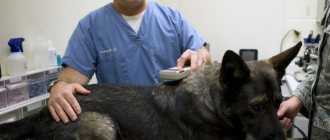Every third four-legged friend has been lost at least once. Unfortunately, 90% of the total number of lost animals are not returned to their owners. Despite the use of collars with phone numbers and branding, many pets disappear without a trace. The microchipping method, recently created for identification purposes, can be used to help find pets. How to find a dog by chip, what are the features of this procedure, read on.
How to find a dog by chip
ORDER OF THE CELTICS
But despite all the precautions, this problem is not uncommon: dogs break off their leashes, cats do not return after “mating,” etc. Also, purebred cats and dogs are sometimes stolen. The “GPS for Animals” system will help protect your pet from such incidents and find it if lost.
A GPS satellite surveillance system is capable of determining the location of an object with high accuracy. A transmitter or beacon attached to the animal’s body monitors its movement, and the owner controls its route on the map in real time.
The transmitter for cats and dogs is attached to the collar. It does not create discomfort for the animal and does not affect its health. In addition, the device can be disguised as a medallion and, if your pet is stolen, it will not attract the attention of intruders. Inside, such beacons contain a miniature chip, which, according to specified conditions, exchanges data with the satellite.
Do not confuse a GPS tracker with a chip that is inserted under the skin of animals in veterinary clinics. The implanted chip is a pet's passport. This chip can only work as a passive RFID (radio frequency) tag, which must be irradiated with the electromagnetic field of the reading device for identification, and the irradiation must occur close. A GPS beacon has no such drawback: it is capable of tracking animals from any distance.
Scanning device
How to stop a dog from barking at the dog and at everyone
Scanners are actively used in veterinary clinics and some other places, for example, at the airport when registering a pet. The device allows you to easily read the information contained in the chip and display it on the screen. Thus, the data transfer process will take a matter of seconds.
The cost of such a scanner depends on its type. Prices in various stores start at 6,000 rubles* and can reach several times that amount.
How to find a dog by chip?
at eight to ten weeks of age. The implantation process continues for a week until connective tissue forms around the capsule. The microchip may move under the skin for the first time (one or two days), so experts do not advise playing active games with the animal or washing it during this time. If your pet wants to chew out the microchip, you can use a special device - a funnel collar.
It is possible to move the implanted chip along the body. However, this does not harm the animal, and the ability to read information from the chip does not change due to its movement.
Thanks to the possibility of chipping, the following issues are resolved:
- First of all, this is the problem of “losses”. In a veterinary clinic, shelter, or foster home, by scanning an animal you can quickly identify the owner. At the moment, not all clinics buy scanners, but this service is in great demand and will become widespread in the near future.
- Legal proof of the animal's ownership. Thanks to the information about the animal and its owner entered into the Unified Register, the procedure for identifying the official owner does not become a problem.
- Registration and maintenance of breeding records in nurseries and clubs.
- Elimination of substitution of high-breed animals at exhibitions and when moving.
- Transporting animals across borders (especially EU countries) On July 3, 2004, new Rules for the importation of pets into the territory of the European Union came into force. The most significant changes to them are the requirement for an identification mark. The new rules apply to dogs, cats, and domestic ferrets. When importing animals into the EU from non-EU countries, cats, dogs and domestic ferrets must be: identified by a distinct brand or an implanted microchip. The transition period during which the stamp will be accepted as an identification mark is 8 years from the date of entry into force of the regulation (3.7.2004), after which the only acceptable method of identification will be a microchip.
Database:
1) ANIMAL-ID database of chipped animals, which in turn is connected to the international Petmaxx database. This project is being led by the Russian one. https://www.animal-id.ru
2) National Database of Electronic Identification of Pets - Pet-ID.
3) International Lost Animal Search System - Petmaxx.
During the chipping procedure, remember:
1) It is better to insert the chip in a clinic that knows the international rules for the import and export of animals. They must have exactly the type of chip recommended by international veterinary customs services
2) Make sure you have a 15-digit number. Outdated chips with 10-digit numbers are often used.
3) After inserting the chip under the skin, be sure to ask the doctor to check it with a reading scanner immediately after the procedure, and again, about a month later, to make sure that the chip has taken root.
4). At home, from your computer, also check information about your animal in the Unified Database using the chip number.
Tags: chipping, microchip scanning, animal registration program, microchip, microchip implantation, animal identification
Comments ()
No comments yet. Yours will be the first!
Action plan for the loss of a microchipped pet
If an animal is missing, you must open the website where it is registered and announce that the pet is wanted. It is important to indicate the microchip number, breed, gender, and special features by which the dog will be immediately recognized during searches. It is advisable to post a photo.
If your dog has a chip, it will be much easier to find him
It is also worth reporting the loss of your pet to the veterinary clinic where the chip was placed. This is necessary so that if the dog is found and brought to the doctor, it can be easily identified. The owner will be informed about the found animal and offered to take it home.
For your information! If the owner suspects that the pet has been stolen, you can contact the Ministry of Internal Affairs. In this case, the police will search for the dog.
How to look for a missing dog: tips and instructions
Thus, providing complete information for customs and veterinary services, including data on vaccinations in electronic form.
A unique feature of our service is the search for microchipped animals all over the world. In just a few seconds, our system will search multiple databases around the world.
We attach a very important role to the reliability and relevance of the data, which, in turn, helps in the event of the loss of an animal to ensure that it is returned to its owner. According to statistics, the probability of returning an identified animal is about 90% . The innovative technologies used create an information community for animal owners and organizations whose field of activity is related to animals. Special services have been created for our users to maintain, record and search for data on both microchipped animals and those lost or found in Russia, the CIS countries and Europe.
Our mission is to popularize the electronic identification system as a modern method to protect your animal from loss, theft, as well as for accurate identification when selling or crossing the border. The database of microchipped animals creates a new electronic passport format that cannot be lost and gives you peace of mind for your pet, wherever you are.
If you want to learn more, we suggest you read the article microchipping animals.
Why enter animal data into the database?
Pedigree dogs with a pedigree and great value for breeding are primarily subject to microchipping. As a result of the procedure, the animal is assigned its personal ID, which contains all the information not only about itself, but also about its owner and ancestors. This helps prevent situations where a mongrel or a mixed breed is passed off as a purebred dog or sold with someone else’s documents.
How to find a dog if it runs away and gets lost
In addition, the database helps in case of a missing animal. Thanks to the chip, you can determine its approximate location. Also, the information it contains, entered into the database, helps to identify the owner and confirm that this is really his pet.
Note! Animals without a chip are often not allowed to participate in exhibitions. If the owner’s plans include traveling with his pet to competitions, it is worth taking care of creating a questionnaire in the database in advance.
Why are we No. 1 in Russia
The largest database of chipped animals in Russia with up-to-date data.
The only base combined with the two largest systems of microchipped animals.
Unique search by microchip number in more than 120 international databases.
The first database in Russia that contains information about animals using NFC tags.
Reliability and, in turn, confidentiality of personal data.
Maintaining information about animal vaccinations.
The animal card is fully translated into English.
The mobile version of the site is always at your fingertips.
Video instructions will help you quickly master working with the portal.
Prompt technical support.
Why is it better to microchip your dog?
Microchipping dogs brings a number of significant benefits to the owner:
- Implanting a microchip is safer and painless than tattooing a dog with a number;
- The biocompatibility of the material with the animal’s body is at the highest level, there will be no allergies;
- The service life is limited only by the life of the pet, all information remains relevant;
- A microchip cannot be faked, nor can it be removed. The brand will turn pale, become overgrown with hair, and can be killed;
- With the microcircuit you can find your lost item, or detect it in case of theft. If someone has found a dog, he can find out who its owners are at the nearest veterinary clinic based on the number from the chip in the database. The address from the collar may fall out, become damaged, or be removed by someone;
- A document such as a pet's chip cannot be interrupted. This attempt will be reflected in the database. You cannot replace an animal at an exhibition or competition, or take it abroad illegally;
- The cost of the sensor is low;
- With the help of microchipping, they control the number and movements of street dogs, find out whether they are sterilized, and whether they have been vaccinated against rabies.
It's also worth learning about the disadvantages. There is a rare case of demagnetization - such a chip cannot be scanned. “Gray” microchips may also be available for sale. Such a device will not contain information about the manufacturer and quality of the product, and data from it cannot be registered in an electronic database. The possibility of identification is already excluded. The price of such counterfeits is low, there is no point in saving, because the original product is not too expensive.
How to find a lost dog
A microchipped dog is much easier to find than one without a chip. The pet dog can be seen immediately, it will be brought to the clinic, the scanner will detect the code, the database will show all the information, the dog will be identified and returned to the owner.
The owner himself declares that the dog is lost. He is waiting for information, in most cases, the operation to return the missing barking friend to the bosom of the family is successful to the delight of everyone.
What is pet microchipping?
Radio frequency identification is the latest method of identifying pets, with the help of which you can also find out and verify the accuracy of any information about the dog and its owner anywhere in the world.
Microchipping of dogs is most relevant for owners of purebred and breeding animals who often travel and participate in international exhibitions. However, even without a show career and trips abroad, microchipping of dogs is necessary for your pet to ensure its maximum safety, because with the help of an electronic identifier you can almost always identify the pet in the event of its theft or replacement, as well as if a particularly frisky pet runs away during daily walks and he will be taken to any veterinary clinic for identification.
Dog microchipping is a modern alternative to applying a breeding mark and is an electronic system consisting of a special microchip, a scanning device and a common database.
The microchip, inserted under the skin of the animal, is a transceiver module and a memory unit, made in integral form in a glass or ceramic case. The microchip's telecoil is activated by the scanner using an electromagnetic signal and transmits to the device a binary code that corresponds to a memory cell in a global database stored on multiple servers.
Microchipping dogs is similar to assigning them a uniform passport, which contains complete information about:
- Country and region of residence of the animal;
- His breed, status, health status and preventive vaccinations;
- Coordinates and contact details of its owner.
Currently, in Russia, microchipping of dogs is carried out in accordance with the ISO “Open Standard”, recognized by the majority of companies operating in the international market. In Russia, a unified database of chipped animals is located on the website, and also allows you to keep an electronic medical history of an animal from any clinic in the country and enter information about vaccination there.
What to do if the animal is not included in the database
Upon completion of microchipping, the dog must be entered into the database and its owner must be informed of its individual number. If for some reason this did not happen, and the staff of the veterinary clinic where the procedure was carried out did not register the dog, the owner must visit it again and clarify why information about his pet is still not available.
Important! In situations where the animal owner cannot contact the clinic and find out about entering data into the database, he can provide all the information about the pet himself. It is worth considering that you often have to pay for such a service.
How is dogs microchipped?
Microchipping of dogs is carried out by subcutaneously injecting a chip into the animal's withers and takes only a few minutes. This mini-operation is necessary once in a lifetime, after which the microchip is surrounded by a connective tissue capsule within a week, preventing its movement, and becomes completely inertial and imperceptible to the animal.
Immediately after the implant is inserted in a clinic, club or nursery, its number is entered into a single database with all the necessary information about the animal and its owner.
The advantages of this procedure, compared to other methods of applying a brand, are:
- It is safe and painless for an animal to introduce a microchip, the dimensions of which do not exceed a few millimeters in length and two millimeters in diameter, and the operation is performed under sterile conditions.
- Simultaneity of chipping . The capsule cannot be damaged or lost, and its potential is designed for more than a hundred years of operation, which is significantly longer than the lifespan of the animal.
- Ease of animal identification when participating in exhibitions and breeding work, as well as safety from the possibility of theft or substitution of expensive dogs with good pedigree
- Possibility of unhindered travel with the animal outside the country. In accordance with current legislation, since 2004, traveling to the EU countries with an animal without an electronic identifier is impossible.
To microchip a dog, no special preparation is required; it can be done in any leading clinic in the country, where a disposable applicator along with a microchip is supplied in sterile packaging, and the procedure itself is similar to an ordinary subcutaneous injection.
Radio-electronic identification devices (RFID), or microchips for short, are the most advanced way to identify animals. Tattoos fade, brands become overgrown, tags and collars get lost, but microchips remain for life!
It is easy to scan animals with convenient hand-held scanners, and implanting chips under the skin is quick and safe. Universal scanning and microchipping of animals will soon become a mandatory daily practice, as in the countries of Europe, America, and Australia. It is no coincidence that the European Union has banned the import of unchipped animals. In Russia, the use of microchips is recommended by law for breeding breeding animals.
The use of microchips in agriculture is useful for the following reasons: - The use of a unique number allows you to track animals from farm to consumer, and check the timeliness of mandatory vaccinations and treatments. — By connecting the scanner to a computer, you can automate the keeping of records about the health of the animal, the procedures used and during breeding.
Microchips of the FDXB type (ISO 11784/5) measuring 12*2 mm, implanted under the skin using a syringe, are covered with biologically inert glass and do not have moving parts or a battery, which allows them to operate indefinitely. Scanners read chip numbers contactlessly at a distance of 3-8 cm. Stationary scanners located in places where livestock pass are connected to a computer that controls the movement of animals using electric gates and their accounting.
Electronic databases generated using microchips and containing medical and genetic information can be used to prepare reports and transferred to new pet owners.
Electronic identification of animals using subcutaneously implanted microchips is an advanced, fast, safe, error-free identification method that prevails throughout the world.
Over the past 10 years, more than 25 million chips have been sold!
What is Pet-ID (PetID) microchip?
A microchip is a chip with an individually programmed number, placed in a capsule made of biologically inert glass measuring 12*2 mm. Using a needle, the microchip is inserted under the animal's skin. The microchip is supplied in a ready-to-use, sterile, disposable syringe or hypodermic needle.
How does the Pet-ID microchip work?
When the microchip enters the scanner’s field of action, it transmits a radio signal containing its unique fifteen-digit number. The scanner shows this number on the display.
How long does a microchip last?
The microchip does not have a battery. The chip provides lifetime electronic identification and protects your pet from loss or theft.
Can the chip move in an animal's body?
As a rule, no. After implantation, the chip is overgrown with a thin layer of connective tissue and remains at the injection site. However, in some animals with poorly defined subcutaneous tissue, the chip may move under the skin in the first days. To prevent this, we recommend higher implantation of the chip to prevent the animal from chewing it out. It is also useful to wear a wide collar in the first two to three days after the procedure.
At what age can animals be microchipped? Animals can be microchipped at any age. Puppies and kittens should be microchipped immediately before their first vaccination, which is at five to six weeks.
Do I need pain relief before microchipping? Microchipping is no more painful than a simple vaccination shot and no anesthesia is required.
Why microchip animals? The animal may get lost or stolen. Having an “electronic passport” will become irrefutable proof of the animal’s ownership and will help bring your pet home. In addition, insurance companies prefer to insure microchipped animals. The import of unchipped animals into the European Union will soon be prohibited. Electronic identification is recommended by law for purebred animals bred for sale. It allows veterinarians to automate the keeping of animal health records.
How can I find out where my animal can be microchipped or scanned? Find your nearest microchipping veterinarian
What animals can be microchipped? Any pets, livestock, rodents, birds, fish, snakes, lizards and others can be microchipped.
Where is the chip usually implanted?
In practice, there are places for standard implantation of chips. In dogs and cats, the chip is implanted under the skin of the back between the shoulder blades. Pigs and cows often have chips sewn into their necks behind their right ears. Goats have a chip implanted at the base of their tail. For horses and other ungulates, in the neck in the middle of the nuchal ligament, 3-5 cm below the mane on the left. In birds, the chip is injected into the chest muscles.
How does the scanner work?
The scanner is brought to the place where the chip is implanted at a distance of 3-5 cm and the button is pressed. The scanner sends a secure radio signal through the skin and reads the chip code. After receiving the code, the scanner emits a beep and shows the chip number on the display, for example 958000000012345.
The scanner can be connected by cable to a computer to automate the entry of the chip number into various programs used by veterinarians to automate their activities.
Does the Pet-ID scanner read chips from other manufacturers?
Yes, the Pet-ID scanner reads both FDXB (967000123456789) and FDXA (FECAVA) (7F7F12E123) chip types.
Who can do microchipping?
Microchipping is a common subcutaneous injection, however, when providing services, this procedure must be performed by a veterinarian. When microchipping their own animals, practice shows that microchipping is successfully handled by breeders and animal owners who have mastered the technique of subcutaneous injections.
What is the microchipping procedure?
The veterinarian scans the animal to determine if the animal has been previously microchipped.
Advantages and disadvantages of chipping
The advantages of the device include:
- the ability to determine the owner of a lost pet;
- microchipping allows you to prove ownership of the dog;
- Using the chip data, you can make sure that the purchased puppy is exactly the one that was previously selected;
- the chip helps prevent the substitution of an animal at an international competition or exhibition;
- the chip simplifies the search for a missing animal;
- each transponder receives a personal code that cannot be replaced or matched;
- the safe material from which the device is made does not grow into soft tissues and does not move along the body of the four-legged friend;
- The product body is made of bioinert glass, so the chip does not cause an allergic reaction or rejection by the body.
Important! Location-based chips for animals are not regulated by law and their use is voluntary. When crossing the border, your pet must have a chip.
Microchipping is a voluntary procedure.
Experts attribute only precautionary measures to the disadvantages of microchipping:
- do not comb or bathe the dog after the procedure;
- the animal may begin to scratch the area on its body with the chip; access can be limited using a special collar.
how to find a microchipped animal
It then scans the chip to confirm its functionality. Using a subcutaneous injection, the veterinarian inserts the chip into the animal and scans it again to ensure that the procedure was successful. The chip number is written down in the animal's passport or a special sticker with the chip number is attached there, which is attached to most chips.
What is the structure of the microchip code and why is it needed?
The first three digits of the code can be the microchip manufacturer code or the country code. The next three digits may be an area code.
This coding is not universally accepted and has lost its meaning with the advent of databases available on the Internet. The structure of the code itself does not convey meaningful information. The code is an identifier that allows you to find information about the animal and its owner in the database. For this reason, we use chips without country and area codes.
At what age can kittens and puppies be microchipped? Kittens and puppies can be microchipped from five weeks of age, prior to vaccination. Of course, microchipping can be done at a later age at any time.
My puppies are very small, can they be microchipped? Of course you can. Our microchips are also used to identify very small animals, such as hamsters, mice, and poultry.
Can wild animals be microchipped? Yes, you can. Microchipping of wild animals is used for scientific purposes to control their numbers, migration and other things.
Where else can microchips be used? Microchips are a universal means of identification. Using chips, you can confirm the authenticity of various valuables, sculptures, paintings, things and antiques.
Microchipping of people is currently being successfully developed. The countries of Latin America became the pioneers of this business. We are receiving requests from Russians about the possibility of using our chips to electronically tag people.
There are no technical problems for microchipping people, but this area of application of chips is not legally defined. People who decide to have a microchip implanted do so at their own peril and risk. However, we believe that implanting chips in people is a very useful procedure, especially for identifying military personnel and those working in high-risk environments, as well as the sick and criminals. We are ready to register such enthusiasts in our database.
Information from the pet-id website
What to do with a found dog
If a person finds a purebred dog on the street that has clearly escaped from its owners or has gotten lost, many problems arise with its arrangement. It is not always known where the animal came from and where its owners live, so for the first time you will have to keep it with you and provide it with maximum comfort.
When a person finds someone else's pet, he should first examine it. A recently lost dog will look healthy and well-groomed. In this case, you can take your time to take the animal home and just stand next to it for a while until the owner shows up.
If the dog is clearly exhausted, dirty, and his fur is matted, he has probably been wandering alone for a long time and needs care. It is important to pick up your pet or take it on an improvised leash made of a scarf or rope and bring it home. There the animal needs to be fed, washed, and warmed up if it is cold outside.
Where to look for a dog's old owners
Checking your dog is the first thing you need to do at home.
The found dog should be examined for the presence of a mark, which may help in finding the owner.
The following things can serve as a hint:
- collar. Often, owners attach notes to it with their phone numbers and names;
- address book A metal tag is also hung on the collar, on which the animal’s name, telephone number and name of the owner, and sometimes place of residence are engraved;
- brand. To find this combination of letters and numbers, you need to check your ears and groin. Helps identify the animal and find out who it belongs to. If the code is difficult to read, it is recommended to shave the hair in this area.
Important! The stigma is of great importance and can help quickly find the owner. It is worth looking for information about the dog in databases, for example, the official website of the RKF.
If no information about the owner can be found, you need to create an advertisement, post copies of it around the city and post information about the pet on special websites. It is important to describe the animal in detail, indicate the place where it was found, and preferably attach a photo.
When and why to carry out the procedure
According to statistics, most often dog owners deliberately undergo this procedure. There are no special restrictions or contraindications for microchipping; the animal must look healthy and reach a certain age. For example, puppies are recommended to undergo surgery when they reach two months of age.
Microchipping is a mandatory procedure for traveling with a pet within the European Union, as well as for participation in international exhibitions. The main argument in favor of microchipping is the ability to obtain information about the animal in case of theft or loss. More often than not, escaped pets end up at a kennel or nearby hospital, where they are scanned and thus returned to their owners.
Advantages of this identification method
- The implantation of the chip is absolutely harmless. The chip does not have any negative impact on the dog’s health and well-being.
- The procedure is painless for the puppy and any other animal.
- The chip does not deteriorate and is a kind of animal passport. Using it, you can easily determine the location and contacts of the owner.
- With a chip, a pet can easily travel with its owner to any country in the world.
- The microchipping procedure is inexpensive; any dog breeder with average income can easily pay for it.
Misconceptions and facts
Many owners are convinced that the microchip has the function of a GPS tracker, and they will be able to track the location of the dog using a satellite. This is an absolute fallacy. The chip doesn't work that way. Moreover, without a scanner it is even impossible to determine whether it is there or not. What then is its meaning and is there a chance to find the missing animal?
The effectiveness of chipping has been proven by many years of experience of various organizations in developed European countries. A huge, multi-stage system, including clinics, shelters, nurseries, catching services, all checkpoints and an international database, sometimes allows an animal to be identified and returned to its owner in a matter of hours.
This is a must know
Dog owners should consider the following:
- Chipping can be done as early as 45-50 days of the puppy’s life.
- Make sure your doctor scans the microchip before the implantation procedure begins and after the device is inserted under the skin.
- After microchipping, carefully inspect the implantation site to make sure that the injection was done correctly and that the chip went under the skin and did not remain in the fur.
- One to two weeks after the procedure, take the time to visit the veterinary clinic and check if the microcircuit is in place.
- When bringing your pet for a routine examination, be sure to ask the doctor to scan the microchip. This way you will make sure that it is in good working order and that it has not “migrated” anywhere.
- Be sure to paste stickers with an individual barcode into the veterinary passport and into the pedigree of your pet.
To summarize, I would like to note that despite possible deviations, most dog breeders are still satisfied that they had their pet microchipped.
Once we decided that our Jack would travel with us, we also went to the veterinary clinic and had him microchipped. Now we can safely travel with him around our country and abroad, without worrying that our beloved little dog will sit and wait for us while we have fun. Now we try to always take it with us, and this is a huge plus.
Despite the fact that currently implantation of a microchip is considered one of the most progressive and reliable methods of identifying an animal, you should not abandon proven methods. A clearly marked brand, address card or information about the owner indicated on the animal’s collar increases the chances of finding and returning a lost tailed dog home.
Take care of your pets!
Are there any complications after microchipping?
The chip capsule is made of hypoallergenic material (biocompatible glass or ceramics) that is not rejected by the body. This means that the immune system does not mistake the chip for an enemy and does not try to dissolve or remove the foreign object. Therefore, complications after microchipping are extremely rare and are often associated with the incompetence of the veterinarian performing the procedure. Electronic chipping of dogs must be carried out with a sterile instrument, and if necessary, additional disinfection of the puncture area is required. The chip itself must also be sterile. Since the chip is inserted deep under the skin, inflammation can be quite severe - swelling, bumps, abscesses. But these are the consequences of the doctor’s negligence, and not the procedure itself. Therefore, it is wiser to contact a trustworthy clinic.
The procedure has no contraindications, except for infectious and chronic skin diseases. Pregnant, elderly animals and small puppies from 1.5 months can be microchipped. Often the procedure is combined with vaccination so that you don’t have to go to the clinic one more time.
Installation Features
The chip is installed in every major veterinary clinic. The duration of the procedure is several minutes.
A microchip is implanted in the area under the withers
Sterility of the procedure
Manufacturers have provided for hygienic safety of manipulation:
- All elements of the device are sterilized and ready for use.
- Sterilization was carried out using ethylene oxide.
- The package is equipped with a yellow group of indicators confirming the completion of sanitary treatment. If they are missing, you should not use the device.
- The needle is equipped with a plastic tip.
The package contains several barcodes intended for pasting into registration documents.
Equipment for chipping
Features of the procedure
It is not recommended to inject yourself.
Features of manipulation:
- Scanning your pet for an implanted device. This is done in order to prevent repeated chipping.
- Checking the functioning of the microchip.
- Comparison of the 15-digit code indicated on the packaging and on the scanner display. The numbers must match.
- Treatment of the area for implantation.
- Introduction of a liquid solution with a microchip.
- Inspection of the implantation area. You need to make sure that the chip goes under the skin and does not get caught on the hair.
- Microchip scanning.
- Entering the code and date of the procedure in the passport.
- Filling out and submitting an application for registration to the Database.
- Pasting stickers with a code into the animal’s passport and pedigree.
A code consisting of 15 characters is entered into the animal’s passport.
Entering the code into the International Database is the most important step. Until it is entered into the system, electronic identification of the dog is not possible.
After manipulation, the animal should not wash the injection area for 2 days. If your dog is a fidgety dog, it is advisable to protect this area with a protective collar. A few weeks after the procedure, you need to visit the veterinary clinic and examine the location of the chip.
Microchip migration
Migration is a deviation of the capsule by more than 20 mm from the area of implantation. The displacement is due to the characteristics of the injection area and the reaction of surrounding tissues to a foreign object.
In rare cases, there is a displacement of the microchip from the implantation site
Factors influencing migration:
- When the chip was implanted, the pet was emotionally agitated, which prevented the injection from being administered correctly.
- The chipping was carried out by a non-professional.
- The injection site was chosen incorrectly, which led to the incorrect placement of the chip in the muscle tissue and caused movement.
An injection performed in the withers area is considered optimal. This is due to the fact that the microchip embedded in this area is in a fixed state due to the pressure of the muscle tissue.
At what age is a dog microchipped?
The procedure is carried out already on the 45th day of the pet’s life. According to international standards, vaccination may not be counted if the dog was not microchipped at the time of vaccination.
Vaccination of puppiesHow much does the procedure cost?
The cost of manipulation varies from 600 to 2,000 rubles. The price is determined by the location of the procedure - at home or in the clinic. In the constituent entities of the Russian Federation, this service is approximately 20% cheaper than in Moscow and the northern capital.
The cost of chipping varies from 600 to 2,000 rubles
In what situations is microchipping necessary?
In addition to the fact that the introduction of a chip increases the chances of success in finding a pet, there are situations prescribed by law. Chipping is mandatory in the following cases:
- Despite the fact that it is possible to transport an animal within Russia without an electronic passport, a chip is required when entering the territory of the United States, EU countries and Israel.
- Participation in international championships.
In all other situations, the chip is installed at the request of the owner.
For international exhibitions, microchipping is mandatory
Contraindications for the procedure
Since this manipulation is safe, there are practically no restrictions on implanting a microchip. Injection is prohibited under the following circumstances:
- Diseases. The work of the immune system in any pathology is aimed at the causative agent of the disease and additional stress on the body is not welcome.
- Presence of a microchip. Re-chipping is prohibited.
If your pet is 6 weeks old, you can start implanting a microchip.
By brand
How to check a dog's pedigree by brand? It's not that easy, but it's quite possible. There are two ways:
- Directly in the RKF itself.
- Via the Internet on special sites dedicated to certain breeds.
If you need to check the pedigree of a dog using the brand number through the RKF, you can call this organization, provide the brand and ask for the pedigree number. This method exists, but rarely leads to positive results.
It is much easier and more effective to check the pedigree of a pet using the brand via the Internet. There are a great many websites - databases that contain information about representatives of a particular breed, and indicate nurseries in whose stud books these animals are registered.
Is microchipping required to travel abroad?
Yes, definitely! At the veterinary control at the airport, they will definitely check whether your pet has a microchip. When planning your trip, carefully study the rules for importing animals into the country. In some countries, for example in the European Union, microchipping is required before or on the day of rabies vaccination.
The cost of microchipping a dog in our clinic is 1200 rubles. The price includes consumables and the work of a veterinarian. For this money you will protect your four-legged friend for life.
Back











